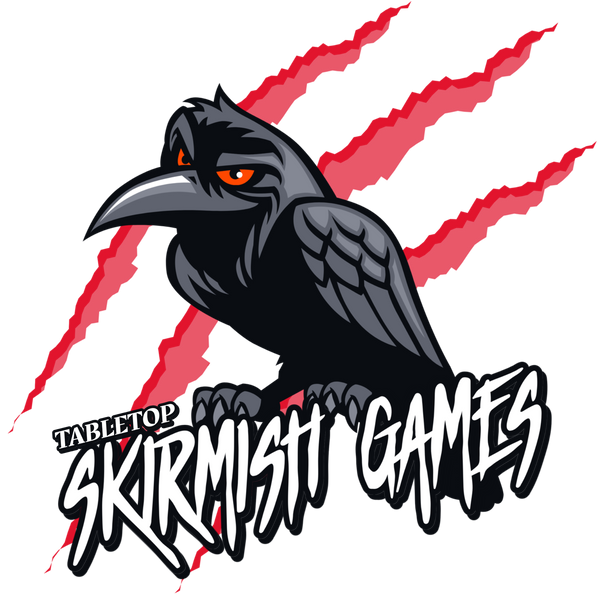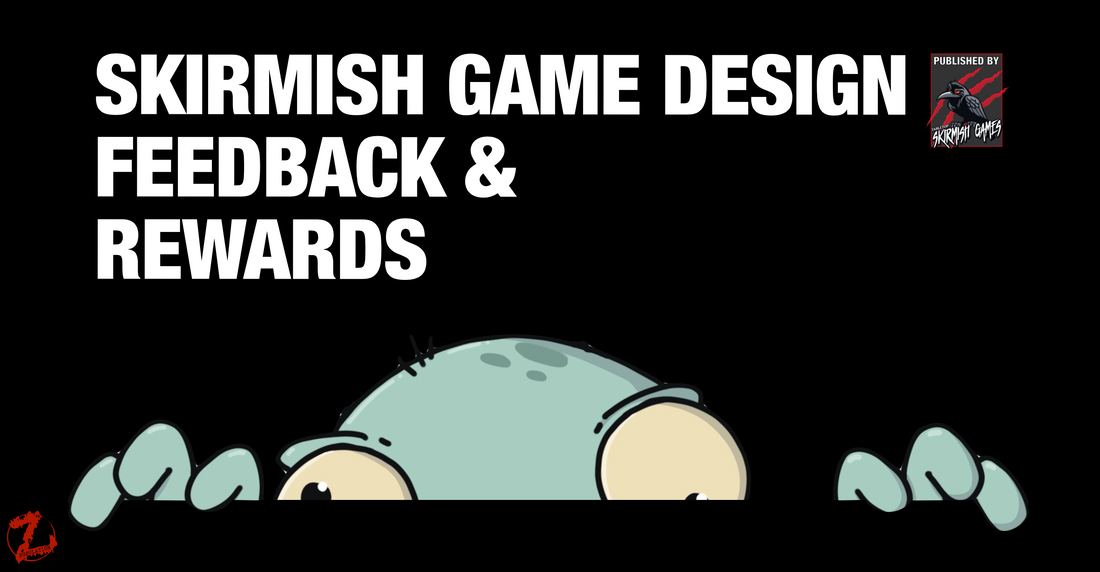Enhancing Tabletop Skirmish Games with Feedback and Rewards
In tabletop skirmish games, feedback and reward systems work together to create a dynamic and immersive gameplay experience. In this blog post, we’ll discuss the significance of these systems, unravel their role in the gameplay loop and examine the ways they enhance player engagement.
The Crucial Role of Feedback in the Gameplay Loop
In a previous blog post we looked at the gameplay loop and the cycle players go through to move the game forward. We found that the gameplay loop represents a continuous cycle that is made up of planning, execution, resolution, and evaluation. This cycle of actions and outcomes will define the player's journey.
Now we’ll go a little deeper and focus on feedback and rewards. Feedback can come in the form of information or rewards, and in tabletop skirmish games, feedback can be thought of as simply a reaction or response to actions performed by a player.
In solo games like Population Z, the game will react to the players actions, while in player versus player games, both the game and the other players will react. The players actions will influence the feedback and then the feedback will influence the players actions.
For example, in Population Z, a player can carry out a search action and trigger a booby trap. The players action is to search and the feedback in this example is information provided on a card or in the scenario rules. The booby trap will cause an effect, either on the players character model or the environment. This effect will require the player to do something like interact with the character dashboard or shape further decisions they need to make to solve a problem or meet an objective.
Visual, Auditory, and Tactile Feedback
In a tabletop skirmish game, there are different types of feedback. These include visual cues, auditory signals, and tactile feedback that come together to form the backbone of a player's understanding and interaction. The shuffling of cards, the satisfying roll of dice, or the tactile sensation of moving miniatures—all contribute to the richness of the gameplay experience too.
Visual, auditory, and tactile feedback help to further immerse players in the skirmish game and go beyond rules and mechanics. Thoughtful feedback systems transport players from the tabletop to the heart of the action, fostering a deeper connection with the narrative and the evolving dynamics of the game.
Think about games that don’t have many elements to them. A game of Dominoes ‘feels’ very different to a game of chess. A skirmish game like Warcry ‘feels’ very different to a larger game like Warhammer 40,000. The number of pieces we interact with, the amount of information we have to process, number of reactions or possible outcomes, all come together to shape the gaming experience. Sometimes there can be too much feedback or not enough, and it’s this balance that makes game creation an art.
Escape form Stalingrad Z is a great example of tactile feedback in tabletop skirmish games. In this World War 2 zombie horror game players play directly on the scenario book. They feel the pages, move the tokens and models around the map, roll dice, interact with NPCs, and update the character dashboard with pegs and markers. It’s incredibly tactile and immersive.
Diverse Rewards for Varied Motivations
Now let’s look at rewards within a gameplay loop. Rewards serve to motivate players to make strategic decisions and engage fully in the skirmish. From tangible rewards like experience points or beneficial items to intangible narrative advancements, the types of rewards vary, catering to different player motivations.
For example, in a heavily narrative-driven skirmish game like Population Z, a player's choice to negotiate with an NPC rather than engage in combat may result in a significant narrative advancement. In one particular Skirmish, Dirk the Deputy is guarding the weapons locker and players can choose to negotiate with him or try to take him out. Negotiate well and Dirk becomes a valuable ally. Choose to get violent and Dirk will shoot causing a loud noise that attracts more zombies your way!
I like to build moral dilemmas into scenarios and these can reward players with a good feeling or sense that they did the right thing in a certain situation. These are powerful rewards that make players care about the game and the characters within it.
More traditional rewards can be fancy weapons, med packs, food, and other gear that gives players a bonus or advantage in certain situations. In campaign games you can give bonuses that help with character development, items to heal injuries or enhancements to improve weapons.
Impact on Player Motivation and Engagement
Different people will be motivated by different things, and that’s why it’s important to offer a diverse range of rewards. We don’t necessarily need a deep understanding of the psychology of rewards but having it in mind when we design our games is a good idea.
Some players will want immediate gratification by finding a powerful weapon, where others might be more interested in achieving objectives that have a wider impact on the narrative and future skirmishes. Again, balancing this makes game creation both incredibly fun and at times frustratingly challenging!
Feedback and Rewards in Unison
Feedback and rewards should combine to create a cohesive gameplay experience. Feedback should be aligned with the type of reward—be it immediate gratification from a successful action or the anticipation of a narrative twist. However you combine them, they should make sense in some form.
Here’s an example of how this cohesion didn’t work in a design element of Population Z. In one of the search tables, one of the items was a ‘dodgy shelf’ that would collapse and make a noise. The noise would then trigger game mechanics and attract more zombies. The dodgy shelf makes perfect sense if searching a house, but when it’s a result that comes up when searching a car or random crate, it makes no sense at all! In this case, I changed the dodgy shelf and introduced a different outcome where the feedback would better match the reward (or this case trap) in any given situation.
Iterative Design and Player Feedback
Fine-tuning feedback and reward systems requires an iterative design process, often shaped by another type of feedback; player feedback. A player-centric approach, involving the gaming community in the evolution of these systems, ensures that the gameplay loop resonates. Play-testing is vital in game design and highlights small inconsistencies. It’s so important to make the feedback and rewards congruent. When you get that right, the players don’t really notice. If you get it wrong, then they certainly do!
Enhancing Tabletop Skirmish Games with Feedback and Rewards
When designing tabletop skirmish games, the interplay of feedback and rewards is an art—a craft that elevates each skirmish from a mere clash of miniatures to a narrative-driven, emotionally resonant experience. By acknowledging the significance of clear feedback and crafting diverse, motivating rewards, skirmish games invite players to immerse themselves fully in the unfolding drama of each skirmish.
I found this blog post quite a heavy one to write. A lot of game creation is intuitive and trying to formalise some aspects of the process can be difficult. The biggest lesson I’ve learned is that play testing is vital to point out the inconsistencies and taking the time to thoroughly play test a game is a must.
I hope you’ve found this blog post helpful and I’d love to hear your thoughts and opinions on the subject, so join in the conversation in the comments below.
Thanks for reading!
Lee
Look out for my new game, Population Z: Welcome to Huntsville, launching in January 2024.

